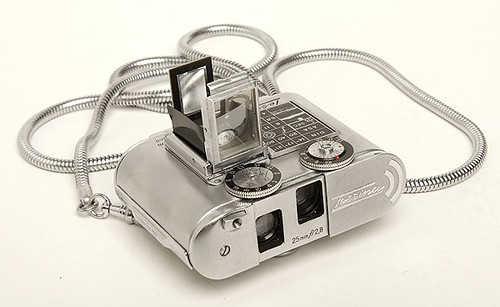Difference between revisions of "Tessina"
(More details and corrected a couple of mistakes.) |
(Corrected my mistake about the clockwork advance; all the cameras have this.) |
||
| Line 19: | Line 19: | ||
Also on the top are the focus and aperture dials. The aperture dial has the frame counter fitted on top, while there is a depth-of-field indicator on the focus dial. There is also an accessory shoe, which normally holds an exposure table. An accessory lightmeter exists, which mounts in place of this table.<ref name=W1></ref> | Also on the top are the focus and aperture dials. The aperture dial has the frame counter fitted on top, while there is a depth-of-field indicator on the focus dial. There is also an accessory shoe, which normally holds an exposure table. An accessory lightmeter exists, which mounts in place of this table.<ref name=W1></ref> | ||
| − | The shutter speed is set on a dial at the back | + | The shutter speed is set on a dial at the back. The shutter release button is on the front, and is threaded for a cable release. |
| + | |||
| + | The camera has automatic clockwork film advance: the advance mechanism can be wound in advance for 5-8 exposures.<ref name=Man></ref> The winding knob is on the back, as is the rewind knob, rewind release, and the [[PC socket]]. | ||
The bottom of the camera has several studs to hold a tripod adapter plate, to avoid making room for a tripod bush in the body.<ref name=W2></ref> | The bottom of the camera has several studs to hold a tripod adapter plate, to avoid making room for a tripod bush in the body.<ref name=W2></ref> | ||
| − | |||
| − | |||
Revision as of 00:02, 2 December 2011

|
| Tessina 35 image by Rick Soloway (Image rights) |
Tessina cameras are a range of subminiature cameras made in Switzerland by Sigrist, and distributed by Concava S. A, from c.1960 for around four decades[1]. For a subminiature, it has three unusual features: it uses 35mm film in special cassettes, running across the bottom of the camera - at a right-angle to the lens axis; it has spring motor film advance, and is a TLR. There are there models, the Tessina 35, the Tessina Automatic 35 and the Tessina 35L. The L model has the lens mounted on the top, in place of the finder, perhaps intended for use covertly.
The image size is 14×21mm - smaller than a standard half-frame camera, but larger than many subminiatures. A daylight loader was available to load the cassettes with 14-20 inches of standard 35mm film, giving between 20 and 30 exposures per cassette.[2][3]
The camera body is metal, with rounded ends, and measures 69×56×27mm (2½×2¼×1 inch). The camera has a coated Tessinon 25mm f/2.8 lens, and a flash-synchronised shutter with speeds 1/2-1/500 second, plus 'B'. The lenses have a sliding cover for protection.
On the top is the ground-glass focusing screen, with a mounting for interchangeable viewfinders. The standard finder is a folding waist-level focusing hood and frame finder; this is similar to the one on most full-size TLR cameras, but the front panel of it has a glass lens in, not a folding panel. A vertical magnifying finder, and a prism finder were available as alternatives; these both have dioptric correction (for the user's eyesight).[4][3]
Also on the top are the focus and aperture dials. The aperture dial has the frame counter fitted on top, while there is a depth-of-field indicator on the focus dial. There is also an accessory shoe, which normally holds an exposure table. An accessory lightmeter exists, which mounts in place of this table.[4]
The shutter speed is set on a dial at the back. The shutter release button is on the front, and is threaded for a cable release.
The camera has automatic clockwork film advance: the advance mechanism can be wound in advance for 5-8 exposures.[3] The winding knob is on the back, as is the rewind knob, rewind release, and the PC socket.
The bottom of the camera has several studs to hold a tripod adapter plate, to avoid making room for a tripod bush in the body.[2]
Notes
- ↑ McKeown, James M. and Joan C. McKeown's Price Guide to Antique and Classic Cameras, 12th Edition, 2005-2006. USA, Centennial Photo Service, 2004. ISBN 0-931838-40-1 (hardcover). ISBN 0-931838-41-X (softcover). Page 210. Wikipedia quotes a date range of 1957-96, but this is unreferenced.
- ↑ 2.0 2.1 1963 Tessina 35 Automatic in red finish, with the prism finder, tripod plate, daylight film loader and other accessories, sold at the May 2010 Westlicht Auction.
- ↑ 3.0 3.1 3.2 User's manual for the Tessina Automatic 35 at Orphan Cameras.
- ↑ 4.0 4.1 Tessina 35 with the prism finder and lightmeter, sold in the November 2011 Westlicht Photographica Auction in Vienna.
Links
- Tessina on subclub.org
- Tessina on Cameraquest
- Tessina on Submin.com
- Tessina, by John Lehman
- Austrian Patent (in German) from 1966 seems to refer to the Tessina.